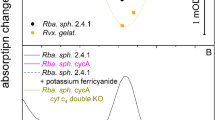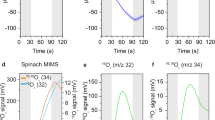Abstract
THE activity of isolated chloroplasts in light, measured by the oxygen evolved from ferric oxalate, has been shown to be relatively high. The ferric oxalate is reduced to ferrous oxalate and oxygen, which is equivalent to the iron reduced, and was measured by means of hæmoglobin. The maximum pressure of oxygen obtainable, however, was only 4 mm. mercury1,2. It has now been proved, by direct measurement of the oxidation of ferrous oxalate, that this low limit of oxygen pressure obtainable simply results from the re-oxidation of the ferrous oxalate produced by the illuminated chloroplasts. If the oxygen uptake due to the oxidation of the ferrous salt can be prevented, oxygen should accumulate to a higher pressure and be capable of direct measurement. It was found that ferricyanide rapidly oxidizes ferrous oxalate in the presence of excess of potassium oxalate.
This is a preview of subscription content, access via your institution
Access options
Subscribe to this journal
Receive 51 print issues and online access
$199.00 per year
only $3.90 per issue
Buy this article
- Purchase on Springer Link
- Instant access to full article PDF
Prices may be subject to local taxes which are calculated during checkout
Similar content being viewed by others
References
Hill, R., Proc. Roy. Soc., B, 127, 192 (1939).
Hill, R., and Scarisbrick, R., Proc. Roy. Soc., B (in the press, 1940).
Author information
Authors and Affiliations
Rights and permissions
About this article
Cite this article
HILL, R., SCARISBRICK, R. Production of Oxygen by Illuminated Chloroplasts. Nature 146, 61–62 (1940). https://doi.org/10.1038/146061a0
Published:
Issue Date:
DOI: https://doi.org/10.1038/146061a0
This article is cited by
-
Earlier researches on the mechanism of oxygen evolution: A personal account
Photosynthesis Research (1993)
-
Manganese K-edge X-ray absorption spectra of the cyclic S-states in the photosynthetic oxygen-evolving system
Photosynthesis Research (1993)
-
Robert Hill, FRS; his published work
Photosynthesis Research (1992)
-
The molecular mechanism of the bicarbonate effect at the plastoquinone reductase site of photosynthesis
Photosynthesis Research (1988)
Comments
By submitting a comment you agree to abide by our Terms and Community Guidelines. If you find something abusive or that does not comply with our terms or guidelines please flag it as inappropriate.



